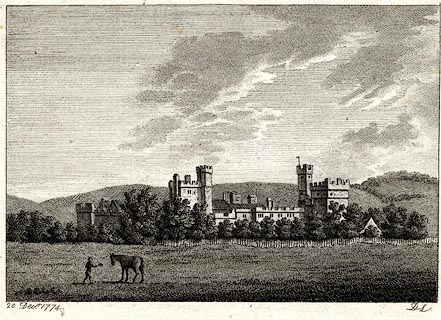

Dove Cottage : 2008.107.490
image:-
© see bottom of page

click to enlarge
Included in The Antiquities of England and Wales, by Francis Grose,.
There is descriptive text below the print and on the reverse:-
NAWORTH CASTLE, CUMBERLAND.
PLATE I.
THIS castle is still entire, and inhabited. For the annexed account of it, and its furniture, I am indebted to Thomas Pennant, Esq. who permitted me to transcribe it from his memorandums. A visit I made to it in August, 1774, enables me to bear testimony to the faithfulness of the description, which here follows in his own words,
"Two miles from Brampton visit Naworth Castle, once beloonging to the Dacres, afterwards the property (I think by marriage) of William Lord Howard, commonly known by the name of Bauld-Wiley.
"IT is a large pile, square, built about a court. In the south side is a gateway, with the arms of the Dacres; over the door, those of the Howards. On the north, it impends over the river Ithing, at a great height; the banks shagged with wood. The whole house is a true specimen of ancient inconvenience, of magnificence and littleness; the rooms numerous, accessible by sixteen stair-cases, with most frequent and sudden ascents and descents into the bargain. The great hall is twenty-five paces long, by nine and a half broad; of a good height; has a gallery at one end, adorned with four vasts crests, carved in wood; viz. a griffin and dolphin, with the scollops; a unicorn, and an ox with a coronet round his neck. In front, is a figure in wood of an armed man; two others, perhaps vassals, in short jackets and caps; a pouch pendant behind, and the mutilated remains of a Priapus to each; one has wooden shoes. These seem the Ludibrium Aulae in those grose days.
"THE top and upper end of the room is painted in squares, to the number of 107, representing the Saxon kings and heroes. The chimney here is five yards and a half broad. Within this is another apartment, hung with old tapestry, a head of Anne of Cleeves; on one side of her, a small picture of a lady in full-length, &c. and many others.
"A long narrow gallery.
"LORD William Howard's bed-room, arms and motto over the chimney. His library, a small room, in a very secret place, high up in one of the towers, well secured by doors, and a narrow stair-case. Not a book has been added since his days, i.e. those of Queen Elizabeth. In it is a vast case, three feet high, which opens into three leaves, having six great pages pasted in, being an account of Joseph of Arimathea, and his twelve disciples, who founded Glastonbury; and at the end, a long history of saints, with the number of years or days for which each could grant indulgences.
"THE roof is coarsely carved. The windows are high, and are to be ascended by three stone steps; such was the caution of the times. It is said Lord William was very studious, and wrote much; that once, when he was thus employed, a servant came to tell him that a prisoner was then just brought in, and desired to know what should be done with him? Lord William, vexed at being disturbed, answered peevishly, Hang him. When he had finished his study, he called, and ordered the man to be brought before him for examination; but found that his orders had been literally obeyed. He was a very severe, but most useful man at that time, in this lawless place. His dungeon instills horror; it consists of four dark apartments, three below, and one above, up a long stair-case, all well secured; in the uppermost is one ring, to which criminals were chained, and the marks where many more have been.
"CLOSE by the library is an ancient Oratory, most richly ornamented on the sides of the cieling with coats of arms and carvings in wood, painted and gilt. On one side is a good painting on wood, in the style of Lucas Van Leyden; it represents the Flagellation of our Saviour, his Crucifixion and Resurrection. Here are also various sculptures in white marble; an abbess, with a sword in her hand, waiting on a king, who is stabbing himself; a monnk, with a king's head in his hand; and several others. This place is well secured; for here Lord William enjoyed his religion in privacy.
"THE chapel is below stairs; the top and part of the side are painted in pannels like the hall; and on one side are the crests of arms and pedigree of the Howards, from Fulcho to 1623 and 1644. Under a great sprawling figure of an old man, with a branch rising from him (on the cieling) is written, Pictor, MDXII. On the great window, in glass, are represented a knight and a lady kneeling; on their mantles pictured these arms, three escallops and chequers."
20 Decr. 1774 / DL / NAWORTH CASTLE, CUMBERLAND. / ...
 Naworth Castle, Cumberland 1
Naworth Castle, Cumberland 1